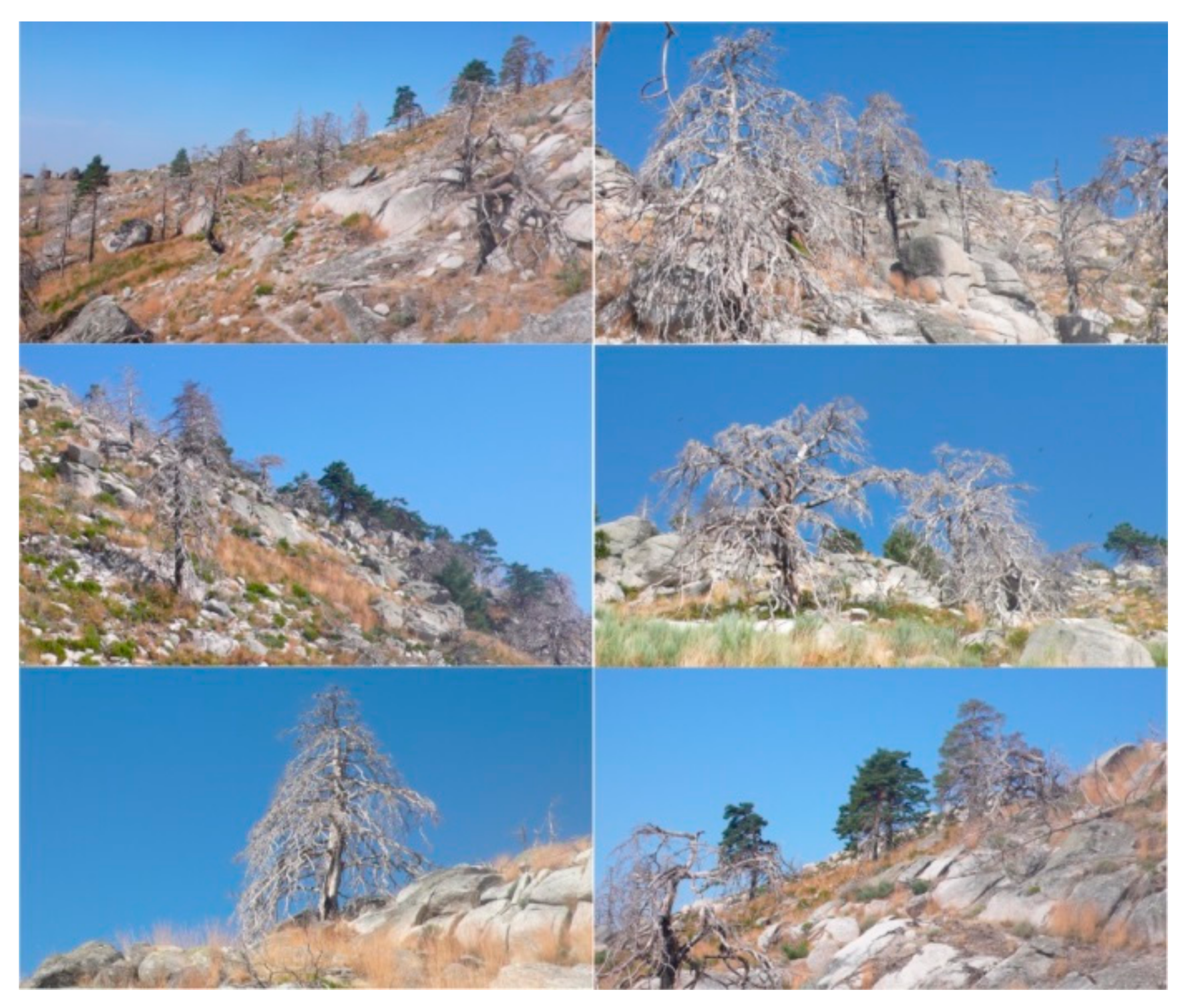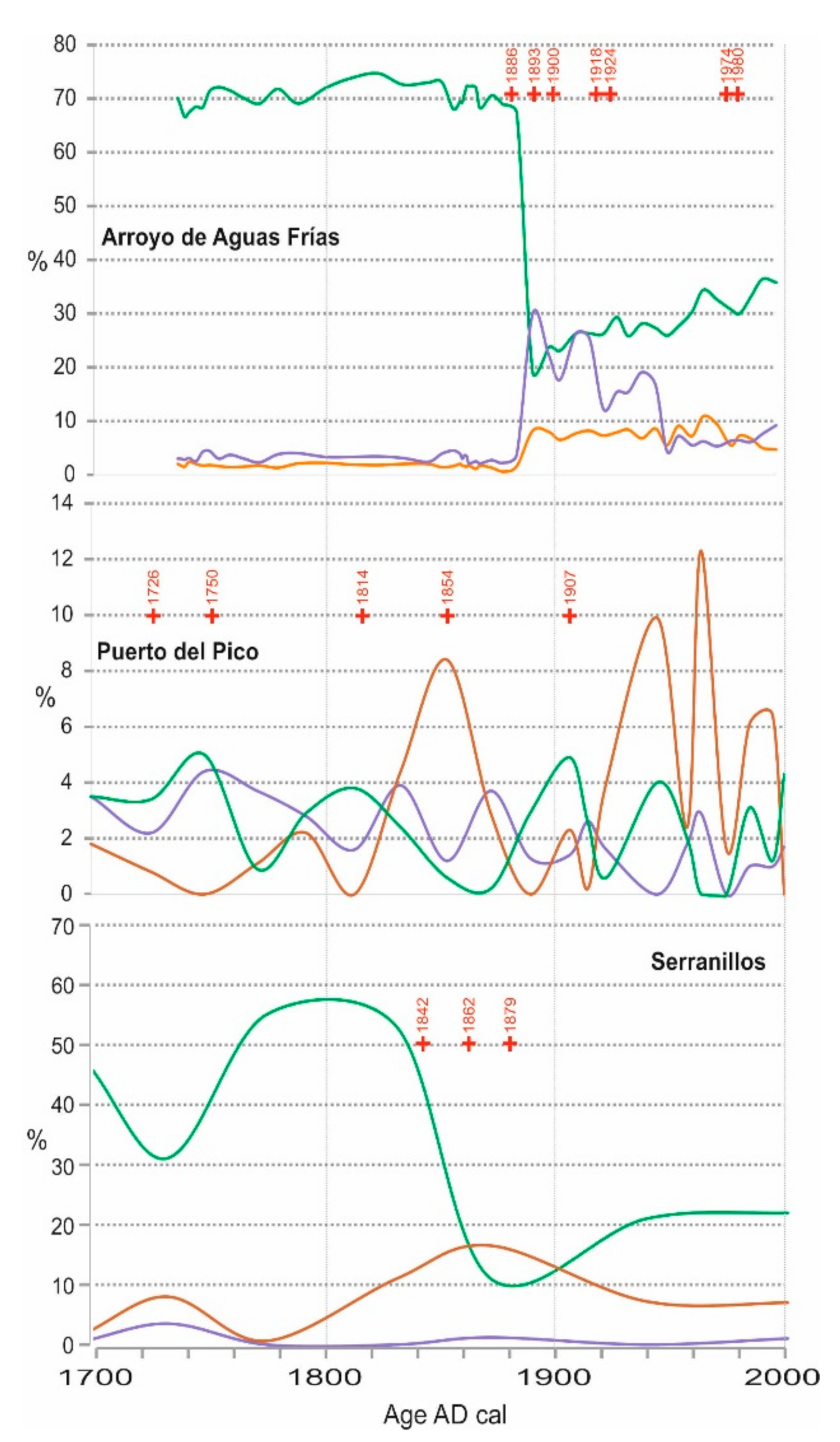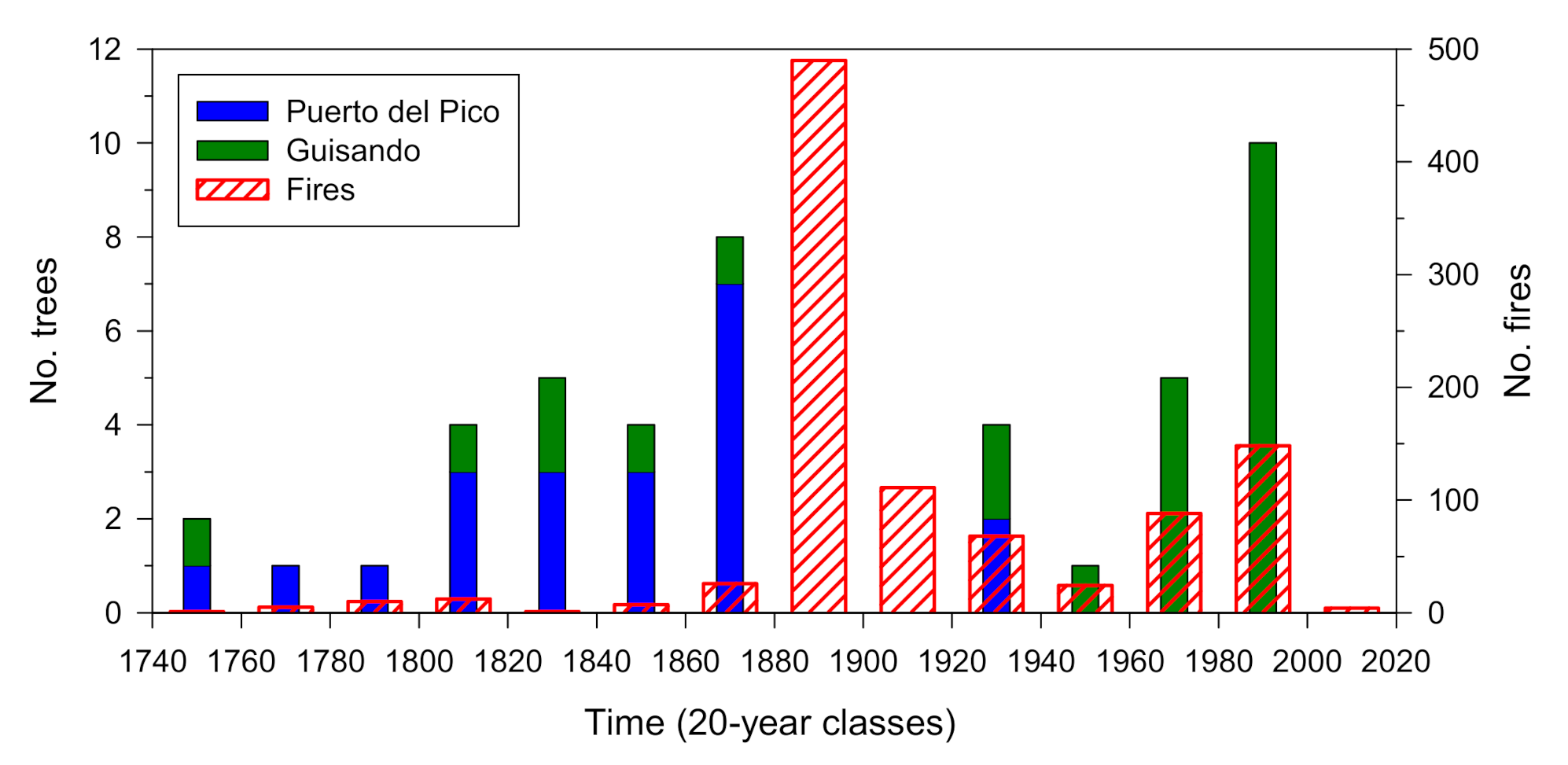Historical Fires Induced Deforestation in Relict Scots Pine Forests during the Late 19th Century
Abstract
:1. Introduction
2. Materials and Methods
2.1. Study Area and Tree Species
2.2. Field Sampling of Scot Pine Forests and Dendroecology
2.3. Paleoecological Methods
2.4. Historical Fire Records Obtained from Archives
3. Results
3.1. Paleoecology: Late-19th-Century Shift in Fire Regime and Reduction of Scots Pine Forests
3.2. Tree Growth
3.3. Fire Proxies in Tree-Ring Records: Recruitment Patterns and Growth Suppressions
4. Discussion
5. Conclusions
Supplementary Materials
Author Contributions
Funding
Institutional Review Board Statement
Informed Consent Statement
Data Availability Statement
Acknowledgments
Conflicts of Interest
References
- Montiel-Molina, C.; Vilar, L.; Sequeira, C.R.; Karlsson, O.; Galiana-Martín, L.; Madrazo-García de Lomana, G.; Palacios-Estremera, M.T. Have historical land use/land cover changes triggered a fire regime shift in central Spain? Fire 2019, 2, 44. [Google Scholar] [CrossRef] [Green Version]
- Pausas, J.G.; Fernández-Muñoz, S. Fire regime changes in the western Mediterranean Basin: From fuel-limited to drought-driven fire regime. Clim. Chang. 2012, 110, 215–226. [Google Scholar] [CrossRef] [Green Version]
- Swetnam, T.W.; Allen, C.D.; Betancourt, J.L. Applied historical ecology: Using the past to manage for the future. Ecol. Appl. 1999, 9, 1189–1206. [Google Scholar] [CrossRef]
- Conedera, M.; Tinner, W.; Neff, C.; Meurer, M.; Dickens, A.F.; Krebs, P. Reconstructing past fire regimes: Methods, applications, and relevance to fire management and conservation. Quat. Sci. Rev. 2009, 28, 555–576. [Google Scholar] [CrossRef]
- Abrams, M.D.; Nowacki, G.J. Global change impacts on forest and fire dynamics using paleoecology and tree census data for eastern North America. Ann. For. Sci. 2019, 76, 8. [Google Scholar] [CrossRef] [Green Version]
- Seidl, R.; Spies, T.A.; Peterson, D.L.; Stephens, S.L.; Hicke, J.A. Searching for resilience: Addressing the impacts of changing disturbance regimes on forest ecosystem services. J. Appl. Ecol. 2016, 53, 120–129. [Google Scholar] [CrossRef] [Green Version]
- Keeley, J.E.; Bond, W.; Bradstock, R.; Pausas, J.; Rundel, P. Fire in the Mediterranean Basin. In Fire in Mediterranean Ecosystems; Keeley, J.E., Bond, W.J., Bradstock, R.A., Pausas, J.G., Rundel, P.W., Eds.; Cambridge University Press: London, UK, 2012; pp. 83–112. [Google Scholar]
- Chergui, B.; Fahd, S.; Santos, X.; Pausas, J.G. Socioeconomic factors drive fire regime variability in the Mediterranean Basin. Ecosystems 2017, 21, 619–628. [Google Scholar] [CrossRef] [Green Version]
- López-Sáez, J.A.; Vargas, G.; Ruiz-Fernández, J.; Blarquez, O.; Alba-Sánchez, F.; Oliva, M.; Pérez-Díaz, S.; Robles-López, S.; Abel-Schaad, D. Paleofire dynamics in Central Spain during the late Holocene: The role of climatic and anthropogenic forcing. Land. Degrad. Dev. 2018, 29, 2045–2059. [Google Scholar] [CrossRef]
- Montiel-Molina, C. Reconstrucción del régimen de incendios del centro de España durante los últimos quinientos años. In Presencia Histórica del Fuego en el Territorio; Montiel-Molina, C., Ed.; Ministerio de Agricultura, Alimentación y Medio Ambiente: Madrid, Spain, 2013; pp. 14–42. [Google Scholar]
- Morales-Molino, C.; Colombaroli, D.; Valbuena-Carabaña, M.; Tinner, W.; Salomón, R.L.; Carrión, J.S.; Gil, L. Land-use history as a major driver for long-term forest dynamics in the Sierra de Guadarrama National Park (central Spain) during the last millennia: Implications for forest conservation and management. Glob. Planet. Chang. 2017, 152, 64–75. [Google Scholar] [CrossRef]
- Morales-Molino, C.; Tinner, W.; García-Antón, M.; Colombaroli, D. The historical demise of Pinus nigra forests in the Northern Iberian Plateau (south-western Europe). J. Ecol. 2017, 105, 634–646. [Google Scholar] [CrossRef] [Green Version]
- Camarero, J.J.; Sangüesa-Barreda, G.; Montiel-Molina, C.; Seijo, F.; López-Sáez, J.A. Past growth suppressions as proxies of fire incidence in relict Mediterranean black pine forests. For. Ecol. Manag. 2018, 413, 9–20. [Google Scholar] [CrossRef]
- Camarero, J.J.; Sangüesa-Barreda, G.; Pérez-Díaz, S.; Montiel-Molina, C.; Seijo, F.; López-Sáez, J.A. Abrupt regime shifts in post-fire resilience are fueled by land use changes in Mediterranean pinewoods. Int. J. Wildl. Fire 2019, 28, 329–341. [Google Scholar] [CrossRef]
- Génova, M.; Gómez, F.; Morla, C. (Eds.) Los Bosques de Gredos a Través del Tiempo; Junta de Castilla y León: Valladolid, Spain, 2009. [Google Scholar]
- López-Merino, L.; López-Sáez, J.A.; Alba-Sánchez, F.; Pérez-Díaz, S.; Carrión, J.S. 2000 years of pastoralism and fire shaping high-altitude vegetation of Sierra de Gredos in central Spain. Rev. Palaeobot. Palynol. 2009, 158, 42–51. [Google Scholar] [CrossRef]
- López-Sáez, J.A.; Sánchez-Mata, D.; Alba-Sánchez, F.; Abel-Schaad, D.; Gavilán, R.G.; Pérez Díaz, S. Discrimination of Scots pine forests in the Iberian Central System (Pinus sylvestris var. iberica) by means of pollen analysis. Phytosociological considerations. Lazaroa 2013, 34, 191–208. [Google Scholar]
- López-Sáez, J.A.; Abel-Shaad, D.; Pérez-Díaz, S.; Blanco González, A.; Alba-Sánchez, F.; Dorado, M.; Ruíz Zapata, B.; Gil-García, M.J.; Gómez González, C.; Franco Múgica, F. Vegetation history, climate and human impact in the Spanish Central System over the last 9000 years. Quat. Int. 2014, 353, 98–122. [Google Scholar] [CrossRef]
- López-Sáez, J.A.; Alba-Sánchez, F.; Sánchez-Mata, D.; Luengo-Nicolau, E. Los Pinares de la Sierra de Gredos. Pasado, Presente y Futuro; Institución Gran Duque de Alba: Ávila, Spain, 2019. [Google Scholar]
- Fernandes, P.M.; Vega, J.A.; Jiménez, E.; Rigolot, E. Fire resistance of European pines. For. Ecol. Manag. 2008, 256, 246–255. [Google Scholar] [CrossRef]
- Caudullo, G.; Welk, E.; San-Miguel-Ayanz, J. Chorological maps for the main European woody species. Data Brief 2017, 12, 662–666. [Google Scholar] [CrossRef]
- Gallardo, J.F.; Cuadrado, S.Y.; González-Hernández, M.I. Suelos Forestales de la Vertiente sur de la Sierra de Gredos; VII Anuario del Centro de Edafología y Biología Aplicada de Salamanca: Salamanca, Spain, 1980; pp. 155–168. [Google Scholar]
- Moreno, J.M.; Viedma, O.; Zavala, G.; Luna, B. Landscape variables influencing forest fires in central Spain. Int. J. Wildl. Fire 2011, 20, 678–689. [Google Scholar] [CrossRef] [Green Version]
- Tapias, R.; Climent, J.; Pardos, J.A.; Gil, L. Life histories of Mediterranean pines. Plant. Ecol. 2004, 171, 53–68. [Google Scholar] [CrossRef]
- Cook, E.R.; Kairiukstis, L.A. (Eds.) Methods of Dendrochronology: Applications in the Environmental Sciences; IIASA: Dordrecht, The Netherlands, 1990. [Google Scholar]
- Holmes, R.L. Computer assisted quality control in tree-ring dating and measurement. Tree-Ring Bull. 1983, 43, 69–78. [Google Scholar]
- Cook, E.R. Turbo Arstan Software: Version 36. Lamont–Doherty Earth Observatory; Palisades: New York, NY, USA, 2002. [Google Scholar]
- International Tree-Ring Data Bank (ITRDB). Available online: https://www.ncdc.noaa.gov/data-access/paleoclimatology-data/datasets/tree-ring (accessed on 1 February 2021).
- Génova, M. Anillos de crecimiento y años característicos en el Sistema Central (España) durante los últimos cuatrocientos años. Bol. R. Soc. Hist. Nat. Sec. Biol. 2000, 96, 33–42. [Google Scholar]
- Génova, M.; Moya, P. Dendroecological analysis of relict pine forests in the centre of the Iberian Peninsula. Biodiv. Cons. 2012, 21, 2949–2965. [Google Scholar] [CrossRef]
- Niklasson, M.; Granström, A. Numbers and sizes of fires: Long-term spatially explicit fire history in a Swedish boreal landscape. Ecology 2000, 81, 1484–1499. [Google Scholar] [CrossRef]
- Duncan, R.P. An evaluation of errors in tree age estimates based on increment cores in kahikatea (Dacrycarpus dacrydioides). N. Zeal. Nat. Sci. 1989, 16, 31–37. [Google Scholar]
- López-Sáez, J.A.; Alba-Sánchez, F.; Robles, S.; Pérez-Díaz, S.; Abel-Schaad, D.; Sabariego, S.; Glais, A. Exploring seven hundred years of transhumance, climate dynamics, fire and human activity through a historical mountain pass in central Spain. J. Mount. Sci. 2016, 13, 1139–1153. [Google Scholar] [CrossRef]
- López-Sáez, J.A.; Sánchez-Mata, D.; Gavilán, R.G. Syntaxonomical update on the relict groves of Scots pine (Pinus sylvestris L. var. Ibérica Svoboda) and Spanish black pine (Pinus nigra Arnold subsp. salzmannii (Dunal) Franco) in the Gredos range (central Spain). Lazaroa 2016, 37, 153–172. [Google Scholar]
- López-Sáez, J.A.; Abel-Schaad, D.; Luelmo-Lautenschlaeger, R.; Robles-López, S.; Pérez-Díaz, S.; Alba-Sánchez, F.; Sánchez-Mata, D.; Gavilán, R. Resilience, vulnerability and conservation strategies in high-mountain pine forests in the Gredos Range, central Spain. Plant. Ecol. Div. 2018, 11, 97–110. [Google Scholar] [CrossRef]
- López-Sáez, J.A.; Blanco-González, A.; Abel-Schaad, D.; Robles-López, S.; Luelmo-Lautenschlaeger, R.; Pérez-Díaz, S.; Alba-Sánchez, F. Transhumance dynamics in the Gredos range (central Spain) during the last two millennia. Environmental and socio-political vectors of change. In Historical Archaeologies of Transhumance across Europe; Costello, E., Svensson, E., Eds.; Routledge: London, UK, 2018; pp. 233–244. [Google Scholar]
- Valdés, C.M. La presencia histórica de los incendios forestales en el centro y este peninsular. Fuentes, metodología y resultados. In Incendios Históricos: Una Aproximación Multidisciplinar; Araque, E., Ed.; UNIA: Baeza, Spain, 1999; pp. 63–110. [Google Scholar]
- Broothaerts, N.; Robles-López, S.; Abel-Schaad, D.; Pérez-Díaz, S.; Alba-Sánchez, F.; Luelmo-Lautenschlaeger, R.; Glais, A.; López-Sáez, J.A. Reconstructing past arboreal cover based on modern and fossil pollen data: A statistical approach for the Gredos Range (Central Spain). Rev. Palaeobot. Palynol. 2018, 255, 1–13. [Google Scholar] [CrossRef]
- Klein, J. The Mesta: A Study in Spanish Economic History 1273–1836; Harvard University Press: Cmabridge, MA, USA, 2013. [Google Scholar]
- Génova, M.; Ortega, P.; Sadornil, E. The effects of fire on Pinus sylvestris L. as determined by dendroecological analysis (Sierra de Gredos, Spain). iForests 2021. in review. [Google Scholar]
- Christopoulou, A.; Fulé, P.Z.; Andriopoulos, P.; Sarris, D.; Arianoutsou, M. Dendrochronology-based fire history of Pinus nigra forests in Mt Taygetos, Southern Greece. For. Ecol. Manag. 2013, 293, 132–139. [Google Scholar] [CrossRef]
- Sarris, D.; Christopoulou, A.; Angelonidi, E.; Koutsias, N.; Fulé, P.Z.; Arianoutsou, M. Increasing extremes of heat and drought associated with recent severe wildfires in southern Greece. Reg. Environ. Chang. 2014, 14, 1257–1268. [Google Scholar] [CrossRef]
- Fulé, P.Z.; Ribas, M.; Gutiérrez, E.; Vallejo, R.; Kaye, M.W. Forest structure and fire history in an old Pinus nigra forest, eastern Spain. For. Ecol. Manag. 2008, 255, 1234–1242. [Google Scholar] [CrossRef]
- Slimani, S.; Touchan, R.; Derridj, A.; Kherchouche, D.; Gutiérrez, E. Fire history of Atlas cedar (Cedrus atlantica Manetti) in Mount Chélia, northern Algeria. J. Arid Environ. 2014, 104, 116–123. [Google Scholar] [CrossRef]
- Sánchez-Salguero, R.; Linares, J.C.; Camarero, J.J.; Madrigal-González, J.; Hevia, A.; Sánchez-Miranda, A.; Ballesteros-Cánovas, J.; Alfaro-Sánchez, R.; García-Cervigón, A.I.; Bigler, C.; et al. Disentangling the effects of competition and climate on individual tree growth: A retrospective and dynamic approach in Scots pine. For. Ecol. Manag. 2015, 358, 12–25. [Google Scholar] [CrossRef]
- Luterbacher, J.; Dietrich, D.; Xoplaki, E.; Grosjean, M.; Wanner, H. European seasonal and annual temperature variability, trends and extremes since 1500. Science 2004, 303, 1499–1503. [Google Scholar] [CrossRef] [Green Version]





| Site (Code) | Source | Latitude N | Longitude W | Altitude (m) | No. Trees (No. Cores) | Dbh (cm) | Age at 1.3 m (years) |
|---|---|---|---|---|---|---|---|
| Puerto del Pico (Pp) | This study | 40.31 | 5.02 | 1600 | 21 (45) | 60.8 (28.5–110.5) | 149 (76–265) |
| Navarredonda (Nv) | ITRDB-spai034 | 40.30 | 5.08 | 1470 | 12 (26) | - | - |
| Hoyos del Espino (Hy) | ITRDB-spai033 | 40.31 | 5.11 | 1465 | 12 (25) | - | - |
| Guisando (Gu) | This study | 40.24 | 5.10 | 1175 | 24 (45) | 53.8 (8.0–180.0) | 53.8 (18–284) |
| Site (Code) | Timespan | Tree-Ring Width (mm) | First-Order AutoCorrelation | Mean Sensitivity | Correlation of Trees with Site Mean Chronology |
|---|---|---|---|---|---|
| Puerto del Pico (Pp) | 1761–2018 | 1.92 ± 0.57 | 0.85 ± 0.07b | 0.23 ± 0.03 | 0.54 ± 0.09a |
| Navarredonda (Nv) | 1769–1985 | 1.88 ± 0.60 | 0.78 ± 0.09b | 0.28 ± 0.05 | 0.64 ± 0.09ab |
| Hoyos del Espino (Hy) | 1813–1985 | 1.82 ± 0.38 | 0.83 ± 0.08b | 0.29 ± 0.05 | 0.73 ± 0.09b |
| Guisando (Gu) | 1744–2015 | 2.28 ± 1.07 | 0.69 ± 0.05a | 0.26 ± 0.06 | 0.51 ± 0.08a |
Publisher’s Note: MDPI stays neutral with regard to jurisdictional claims in published maps and institutional affiliations. |
© 2021 by the authors. Licensee MDPI, Basel, Switzerland. This article is an open access article distributed under the terms and conditions of the Creative Commons Attribution (CC BY) license (https://creativecommons.org/licenses/by/4.0/).
Share and Cite
Camarero, J.J.; Sangüesa-Barreda, G.; Montiel-Molina, C.; Luelmo-Lautenschlaeger, R.; Ortega, P.; Génova, M.; López-Sáez, J.A. Historical Fires Induced Deforestation in Relict Scots Pine Forests during the Late 19th Century. Fire 2021, 4, 29. https://0-doi-org.brum.beds.ac.uk/10.3390/fire4020029
Camarero JJ, Sangüesa-Barreda G, Montiel-Molina C, Luelmo-Lautenschlaeger R, Ortega P, Génova M, López-Sáez JA. Historical Fires Induced Deforestation in Relict Scots Pine Forests during the Late 19th Century. Fire. 2021; 4(2):29. https://0-doi-org.brum.beds.ac.uk/10.3390/fire4020029
Chicago/Turabian StyleCamarero, J. Julio, Gabriel Sangüesa-Barreda, Cristina Montiel-Molina, Reyes Luelmo-Lautenschlaeger, Paula Ortega, Mar Génova, and José Antonio López-Sáez. 2021. "Historical Fires Induced Deforestation in Relict Scots Pine Forests during the Late 19th Century" Fire 4, no. 2: 29. https://0-doi-org.brum.beds.ac.uk/10.3390/fire4020029









